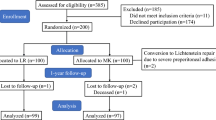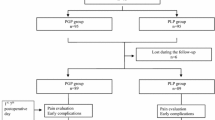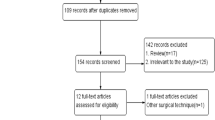Abstract
Introduction
Mesh plug is an established and effective method for repair of inguinal hernia. The ProLoop plug® (Atrium) is a recently developed mesh plug with a novel configuration, which may offer advantages over the standard Prefix plug® (Bard) or the Lichtenstein repair. This two-centre double-blinded randomised control trial assessed the short- and medium-term outcomes, comparing the above three methods.
Patients and methods
Consecutive patients over the age of 18 years with primary unilateral inguinal hernia were randomised to receive a Lichtenstein tension free mesh repair (LTFM), Perfix® plug (Bard) (PF) or ProLoop® plug (Atrium) (PL) repair. Follow-up was at 2 weeks, 6 months and 12 months. Endpoints were operative time, hospital stay, bodily pain scores, return to daily activity and complications.
Results
A total of 295 consecutive patients were recruited to the study. Ninety-three patients were randomised to receive PL plug repairs, 101 PF plug repairs and 101 LTFM repairs. There was no significant difference among the three groups in terms of age, sex or BMI. There was no significant difference among the groups in terms of operative time (PL vs PF P = 0.92; PL vs LTFM P = 0.52), hospital stay (PL vs PF P = 0.74; PL vs LTFM P = 0.44), bodily pain scores (at 12 months PL vs PF P = 0.84, PL vs LTFM P = 0.85, PF vs LTFM P = 0.16), complication rates or return to daily activity.
Conclusions
The ProLoop® plug (Atrium) is a safe and effective method of repairing primary inguinal hernias. Its novel lightweight configuration does not increase the risk of recurrence when compared to thicker mesh plugs, and it may offer benefit in terms of long-term patient comfort. The ProLoop® plug (Atrium) represents a new effective alternative to the established mesh repairs.


Similar content being viewed by others
References
Usher FC, Gannon JP (1959) Marlex mesh, a new plastic mesh for replacing tissue defects. I. Experimental studies. AMA Arch Surg 78:131–137
Lichtenstein IL, Shulman AG, Amid PK, Montllor MM (1989) The tension-free hernioplasty. Am J Surg 157:188–193
Kurzer M, Belsham PA, Kark AE (2003) The Lichtenstein repair for groin hernias. Surg Clin North Am 83:1099–1117
Gilbert AI (1989) An anatomic and functional classification for the diagnosis and treatment of inguinal hernia. Am J Surg 157:331–333
Robbins AW, Rutkow IM (1993) The mesh-plug hernioplasty. Surg Clin North Am 73:501–512
Rutkow IM, Robbins AW (1998) The Marlex mesh PerFix plug groin hernioplasty. Eur J Surg 164:549–552
Frey DM, Wildisen A, Hamel CT, Zuber M, Oertli D, Metzger J (2007) Randomized clinical trial of Lichtenstein’s operation versus mesh plug for inguinal hernia repair. Br J Surg 94:36–41
Kingsnorth AN, Porter CS, Bennett DH, Walker AJ, Hyland ME, Sodergren S (2000) Lichtenstein patch or Perfix plug-and-patch in inguinal hernia: a prospective double-blind randomized controlled trial of short-term outcome. Surgery 127:276–283
Pelissier EP, Marre P (1998) The use of a plug in inguinal hernia. J Chir (Paris) 135:223–227
Goldstein HS, Rabaza JR, Gonzalez AM, Verdeja JC (2003) Evaluation of pain and disability in plug repair with the aid of a personal digital assistant. Hernia 7:25–28
Varga L, Leindler L, Hodi Z, Petri A, Balogh A (2000) A new method of tension-free inguinal hernia repair: “PROLENE hernia system” (PHS) (pilot study). Magy Seb 53:67–68
Trabucco E, Campanelli P, Cavagnoli R (1998) New polypropylene hernia prosthesis. Minerva Chir 53:337–341
Swarnkar K, Hopper N, Nelson M, Feroz A, Stephenson BM (2003) Sutureless mesh-plug femoral hernioplasty. Am J Surg 186:201–202
Rutkow IM, Robbins AW (1995) Mesh plug hernia repair: a follow-up report. Surgery 117:597–598
Neumayer L, Giobbie-Hurder A, Jonasson O, Fitzgibbons R Jr, Dunlop D, Gibbs J, Reda D, Henderson W (2004) Open mesh versus laparoscopic mesh repair of inguinal hernia. N Engl J Med 350:1819–1827
Huang CS, Huang CC, Lien HH (2005) Prolene hernia system compared with mesh plug technique: a prospective study of short- to mid-term outcomes in primary groin hernia repair. Hernia 9:167–171
Author information
Authors and Affiliations
Corresponding author
Rights and permissions
About this article
Cite this article
Sanders, D.L., Samarakoon, D.H., Ganshirt, S.W. et al. A two-centre blinded randomised control study comparing the Lichtenstein patch, Perfix® plug and ProLoop® plug in the repair of primary inguinal hernia. Hernia 13, 499–503 (2009). https://doi.org/10.1007/s10029-009-0540-z
Received:
Accepted:
Published:
Issue Date:
DOI: https://doi.org/10.1007/s10029-009-0540-z




